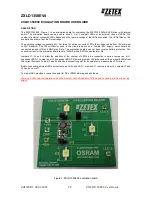
Selecting Equalization / Boost Level for TUSB217
4
SLLU308A – September 2018 – Revised November 2018
Copyright © 2018, Texas Instruments Incorporated
TUSB217EVM User's Guide
Table 1. TUSB217 EVM Jumper Descriptions
Jumper
Functionality and Configuration
J1
●
Populated – EVM powered from VBUS
●
Not Populated – EVM can be powered from external supply (3.3V to 6.5V) injected on pin 2.
NOTE:
The TUSB217EVM will not operate below 3.3V due to the use
of an on-board 3.3V regulator to power the device.
J3
●
Populated – BOOST Level = 0
●
Not Populated – BOOST set by SW2
J4
●
Populated [1-2] – SCL pullup
●
Populated [2-3] – Connect Detect LED enabled
●
Not Populated – default mode
J5
●
Populated [1-2] – SDA pullup
●
Populated [2-3] – SDA pulldown
●
Not Populated – default mode
J2
●
Populated – Enable HS LED enabled
●
Not Populated – RX_SEN set by SW3
5
Selecting Equalization / Boost Level for TUSB217
The primary purpose of the TUSB217 is to restore the signal integrity of a USB High-Speed channel up to
the USB connector. The platform goal is to pass the USB Near-End or Far-End Eye Mask with the
TUSB217 in the best location.
A typical use case is to place the TUSB217 close to the USB connector on a Host platform in order to
pass Near-End Eye Mask testing. This includes systems where the USB connector may be placed at the
Far-End of a cable.
Typical EQ and Boost recommendations based on cable length (28 AWG USB Cable.
Table 2. EQ/Boost Setting Based on Cable Length
Cable Length
TUSB217 BOOST
TUSB217 RX SEN
0m - 1m
EQ1
MID
1m – 2m
EQ1
MID
2m – 3m
EQ1
HIGH
3m – 5m
EQ2
HIGH
6
EVM Operation
To install the EVM, perform the following steps:
1. Attach a USB2 or USB3 cable from a Host PC Type A connector to the Type B connector (P1) of the
TUSB217 EVM.
2. Attach a USB device either via cable or directly plugged into the Type A receptacle connector (P2) on
the TUSB217 EVM.






























